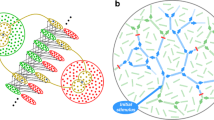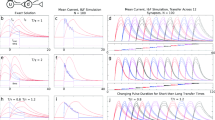Abstract
This paper examines the feasibility of manifesting compositionality by a system of synfire chains. Compositionality is the ability to construct mental representations, hierarchically, in terms of parts and their relations. We show that synfire chains may synchronize their waves when a few orderly cross links are available. We propose that synchronization among synfire chains can be used for binding component into a whole. Such synchronization is shown both for detailed simulations, and by numerical analysis of the propagation of a wave along a synfire chain. We show that global inhibition may prevent spurious synchronization among synfire chains. We further show that selecting which synfire chains may synchronize to which others may be improved by including inhibitory neurons in the synfire pools. Finally we show that in a hierarchical system of synfire chains, a part-binding problem may be resolved, and that such a system readily demonstrates the property of priming. We compare the properties of our system with the general requirements for neural networks that demonstrate compositionality.
Similar content being viewed by others
References
Abeles M (1982) Local Cortical Circuits-An Electrophysiological Study. Springer-Verlag, Berlin.
AbelesM(1991) Corticonics, Neural Circuits of the Cerebral Cortex. Cambridge University Press.
Abeles M, Prut Y, Vaadia E, Bergman H (1994) Synchronization in neuronal transmissionand its importance for information processing. In: G. Buzsaki, et al., eds. Temporal Coding in the Brain, pp. 39–50.
Abeles M, Vaadia E, Bergman H, Prut Y, Haalman I, Slovin H (1993) Dynamics of neural interaction in the frontal cortex of behaving monkeys. Concepts in Neuroscience 4(2): 131–158.
Aertsen A, Diesmann M, Gewaltig MO (1996) Characterization of synfire activity by propagating pulse packets. In: JM Bower, ed. Advances in Computational Neurosc. Plenum.
Aertsen A, Diesmann M, Gewaltig MO (1996) Propagation of synchronous spiking activityin feedforward neural networks. J. Physiology90(3/4): 243–247.
Arnoldi R, Brauer W (1996) Synchronization without oscillatory neurons. Biol. Cybernet. 74: 209–223.
Barlow H (1995) The neuron doctrine in perception. In: M. Gazzaniga, ed., The Cognitive Neuronsciences pp. 415–435. MIT Press.
Biederman I, Hummel JE (1992) Dynamical binding in a neural network for shape recognition. Psychol. Review 99(3): 480–517.
Bienenstock E (1991) Notes on the growth of a composition machine. In: D. Adler, E. Bienenstock. Laks, eds., Proceeding of the Royaumont Interdisciplinary Workshop on Compositionality in Cognition and Neural Network-I.
Bienenstock E (1992) Suggestions for a Neurobiological Approach to Syntax. Private Communication.
Bienenstock E (1995) A model of neocortex. Network: Comput. Neural Syst. 6: 179–224.
Bienenstock E (1996) Composition. In: A. Aertsen and V. Braitenberg, eds., Brain Theory: Biological Basis and Computational Theory of Vision. Elsevier.
Bienenstock E, Geman S (1994) Compositionality. In: Michael Arbib, ed., The Handbookof Brain Theory and Neural Networks. MIT Press.
Bienenstock E, Geman S, PotterD(1997) Compositionality, mdl priors, and object recognition.In: MI Jordan, MC Mozer, T Petsche, eds., Advances in Neural Information Processing Systems, vol. 9. MIT Press.
Braitenberg V (1986) Two views of the cerebral cortex. In: G Palm, A Aertsen, eds., Brain Theory Springer, Berlin, pp. 81–96.
Carreiro LRR, Haddad H Jr, Baldo MVC (2003) The modulation of simple reaction time by the spatial probability of a visual stimulus. Braz. J. Med. Biol. Res. 36: 907–911.
Cohen A, Shoup R (2000) Response selection target for conjunctive targets. J. Experim. Psych.: Human Percep. Perform. 26: 391–411.
Damasio AR (1989) Time-locked multiregional retroactivation: A systems-level proposal for the neural substrates of recalll and cognition. Cognition 33: 25–62.
Dickinson SJ, Pentland AP, Rosenfeld A (1992) From volumes to views: An approach to 3-d object recognition. Image Understanding 55: 130–154.
Diesmann M, Gewaltig MO, Aertsen A (1999) Stable propagation of synchronous spiking in cortical neural networks. Nature 402: 529–533.
Doursat R (1991) Contribution `a l'etude des representations dans le syst`eme nerveux et dans les reseaux de neurones formels. PhD thesis, Universite Paris, 6.
Eckhorn R, Brauer R, Jordan W, Brosch M, Kruse W, Munk M, Reitboeck HJ (1988) Coherent oscillations: A mechanism for feature linking in the visual cortex? Biol. Cyber. 60: 121–130.
Ellis W (1938) A Source Book of Gesstalt Psychology. Humanities Press.
Van Essen DC, Felleman DJ, De Yoe EA, Olavarria J, Knierim J (1991) Modular and hierarchical organization of extrastriate visual cortex in macaque monkey. In: Cold Spring Harbor Symposiom of Quantitative Biology vol. 55, pp. 679–696.
Geman S, Potter DF, Chi Z (1998) Composition systems. Technical report, Division of Applied Mathematics, Brown University.
Gray CM (1999) The temporal correlation hypothesis of visual feature integration: Still alive and well. Neuron 24: 31–47.
Gray CM, Singer W (1989) Stimulus-specific neuronal oscillations in orientation columns of cat visual cortex. Proc. Natl. Acad. Sci USA 92: 6655–6662.
Hayon G (2004) Modeling compositionality in biological neural networks by dynamic binding of synfire chains. PhD thesis, the Hebrew University in Jerusalem, 2003.
Hayon G, Abeles M, Lehmann D (2004) A model for reresenting the dynamics of a system of synfire chains. J. Comp. Neurosci., submitted.
HebbDO(1949) Organization of Behaviour.Wiley Press, NewYork.
Herrmann M, Hertz J, Prugel-Bennett A (1995) Analysis of synfire chains. Network: Computation in Neural Systems 6: 403–414.
Hertz J, Krogh A, Palmer R (1991) Introduction to the Theory of Neural Computation. Addison-Wesley Publishing Company.
Hertz J, Prugel-Bennett A (1995) Learning short synfire chains by self-organization. Network: Computation in Neural Systems.
Horn D, Levy N, Meilijson I, Ruppin E (1999) Distributed synchrony of spiking neurons in a hebbian cell assembly. In: NIPS99.
Horn D, Opher I (1996) The importance of noise for segmentation and binding in dynamical neural systems. International Journal of Neural Systems 7(4): 529–535.
Horn D, Sagi D, UsherM(1991) Segmentation, binding and illusory conjunctions. Neural Comput. 3: 510–525.
Hummel JE (2001) Complementary solution to the binding problem in vision: Implications for shape perception and object recognition. Visual Cognition 8: 489–517.
Hummel JE, Stankiewicz BJ (1996) An architecture for rapid hierarchical structural description. In: T Inui, J McClelland, eds., Information Integration in Perception and Communication vol. XVI of Attention and Performance, MIT Press, Cambridge, MA, pp. 93–121.
Litvak V, Sompolinsky H, Segev I, Abeles M(2002) On the transmission of rate code in long feed-forward networks with excitatoryinhibitory balance. J. Neurosci. 23: 3006–3015.
MaassW(1997) Fast sigmoidal networks via spiking neurons. Neural Computation 9: 279–304.
MaassW, Natschlager T (1997) Network of spiking neurons can emulate arbitrary hopfield nets in temporal coding. Network: Computation in Neural Systems.
Postma EO, van der Herik HJ, Hudson PTW (1996) Robust feedforward processing in synfire chains. International Journal of Neural Systems 7(4): 537–542.
Potter DF (1999) Compositional Pattern Recognition. PhD thesis, Division of Applied Mathematics, Brown University.
Prut Y, Vaadia E, Bergman H, Haalman I, Slovin H, AbelesM(1998) Spatiotemporal structure of cortical activity: Properties and behavioral relevance. J. Neurophysiol. 79(6): 2857–2874.
Reynolds JH, Desimone R (1999) The role of neural mechanisms of attention in solving the binding problem. Neuron 24: 19–29.
Riesenhuber M, Poggio T (1999) Are cortical models realy bound by the “binding problem”. Neuron 24: 87–93.
Rissanen J (1989) Stochastic Complexity in Statistical Inquiry.World Scientific Press.
Roskies AL (1999) The binding problem. Neuron 24: 7–9.
Shadlen MN, Newsome WT(1998) The variable discharge of cortical neurons: Implications for connectivity, computation, and information coding. J. Neurosci. 18(10): 3870–3896.
Shadlen MN, Movshon A (1999) Synchrony unbound: A critical evaluation of the temporal binding hypothesis. Neuron 24: 67–77.
Shastri L, Ajjanagadde V(1993) From simple associations to systematic reasoning: A connectionist representation of rules, variables and dynamic binding using temporal synchrony. Behav. Br. Sci. 16: 417–494.
SingerW(1999) Neural synchrony:Aversatile code for the definition of relations? Neuron 24: 49–65.
Sougne JP, French RM (2001) Synfire chains and catastrophic interference. In: Proceedings of the 23rd Annual Conferences of the Cognitive Science Society. Lawrence Erbaum Ass., Mahwah, NJ.
Sterratt DC (1999) Is a biological temporal learning rule compatible with learning synfire chains? In: Proceedings of ICANN 99 can be found at http://www.cogsci.ed.ac.uk/ dcs/research.html.
Treisman A (1996) The binding problem. Current Opinion in Neurobiology 6: 171–178.
Treisman A (1999) Solutions to the binding problem: Progress through controversy and convergence. Neuron 24: 105–110.
Triesch J, von der Malsburg C (1996) Binding-A proposed experiment and a model. In: Proceedings of the International Conference on Artificial Neural Networks Bochum.
Ullman S (1989) Aligning pictorial descriptions: An approach to object recognition. Cognition 32(3): 193–254.
Ullman S (1996) High-level Vision. The MIT Press.
Villa AEP, Tetko IV, Holand B, Najem A (1999) Spatiotemporal activity patterns of rat cortical neurons predict responses in a conditioned task. In: Proceedings of the National Academy of Science USA 96: 1106–1111.
von der Malsburg C (1981) The Correlation Theory of Brain Function, Springer, Berlin, vol. Models of Neural Networks II, Chap. 2, pp. 95–119.
von der Malsburg C (1987) Synaptic plasticity as basis of brain organization.In: JP Changeuxand, M Konishi, eds., The Neural and Molecular Bases of Learning Wiley, New York. Exact dynamics in feedforward neural networks. Europhysics Letters 38(8): 631–636.
Zucker RS (1989) Short-term synaptic plasticity. Ann. Rev. Neuroscience 12: 13–31.
Author information
Authors and Affiliations
Rights and permissions
About this article
Cite this article
Abeles, M., Hayon, G. & Lehmann, D. Modeling Compositionality by Dynamic Binding of Synfire Chains. J Comput Neurosci 17, 179–201 (2004). https://doi.org/10.1023/B:JCNS.0000037682.18051.5f
Issue Date:
DOI: https://doi.org/10.1023/B:JCNS.0000037682.18051.5f




